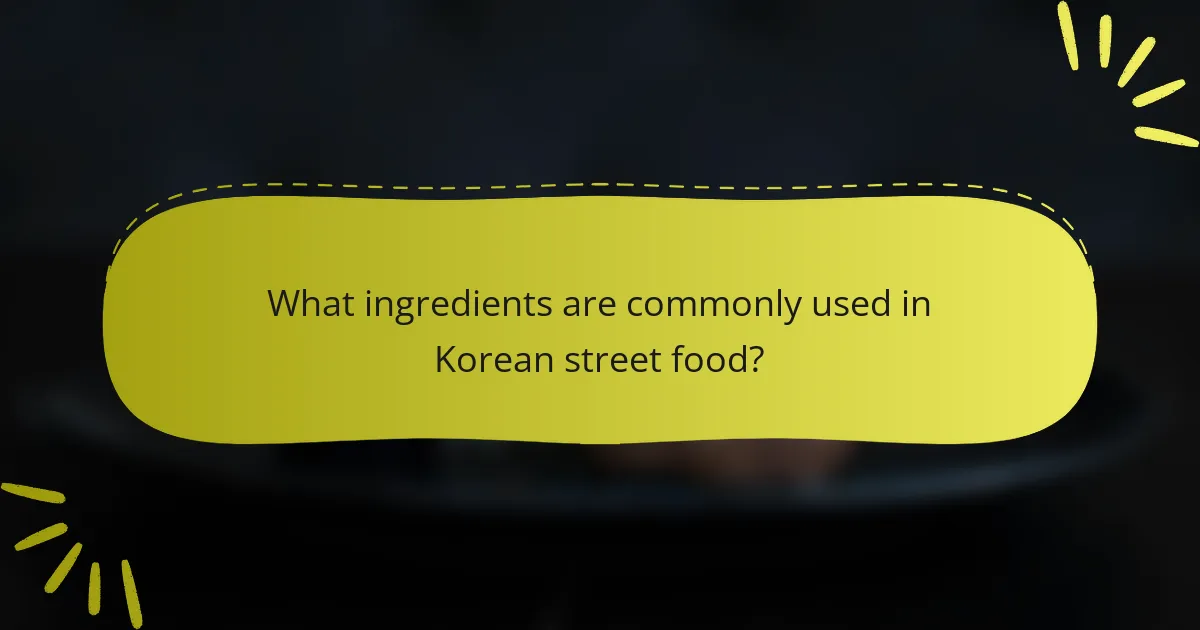Korean street food is a vibrant aspect of South Korean culture, featuring a variety of quick, flavorful dishes sold by street vendors. Key popular items include tteokbokki, spicy rice cakes, and hotteok, sweet pancakes filled with syrup. Common ingredients in these dishes consist of rice, vegetables, meats, and distinctive seasonings like gochujang and soy sauce, reflecting traditional Korean cuisine. To experience authentic Korean street food, visitors are encouraged to explore local markets such as Myeongdong in Seoul and Gwangjang Market, where fresh dishes are prepared on-site, showcasing rich culinary traditions and vendor histories.

What is Korean Street Food?
Korean street food consists of various quick and flavorful dishes sold by vendors on the streets of South Korea. It is a significant part of Korean culture and cuisine. Popular items include tteokbokki, which are spicy rice cakes, and hotteok, a sweet pancake filled with syrup. Street food is often enjoyed during festivals and markets, creating a vibrant atmosphere. The food is typically affordable and convenient for on-the-go consumption. Many dishes are characterized by bold flavors and unique textures, appealing to a wide range of tastes. Street food vendors often use fresh ingredients, enhancing the overall quality of the offerings.
How did Korean street food culture develop over the years?
Korean street food culture developed significantly from the 1960s to the present. Initially, it emerged from traditional market stalls selling simple snacks. Popular items included tteokbokki and odeng, which catered to the local working class. The 1988 Seoul Olympics boosted visibility and popularity, attracting international attention. In the 1990s, globalization introduced diverse flavors and cooking methods. The rise of social media in the 2000s further promoted street food trends. Today, Korean street food is celebrated worldwide, with fusion dishes and gourmet offerings. Events like street food festivals showcase this vibrant culture, reflecting its continuous evolution and adaptation.
What historical influences shaped the current street food scene in Korea?
The current street food scene in Korea is shaped by historical influences such as the Joseon Dynasty and Japanese colonial rule. During the Joseon Dynasty, food was often sold in markets, reflecting local agricultural practices. Street vendors provided accessible meals to the working class, establishing a culture of quick, affordable food. Japanese colonial rule from 1910 to 1945 introduced new ingredients and cooking methods, influencing Korean street food. Post-war urbanization led to the rise of food stalls catering to busy city dwellers. The globalization of food culture in recent decades has further diversified street food offerings. Today, these influences contribute to a vibrant and evolving street food landscape in Korea.
How do modern trends impact traditional street food offerings?
Modern trends significantly influence traditional street food offerings by introducing innovative flavors and presentation styles. Street food vendors adapt to consumer preferences for healthier options. For instance, many now offer vegetarian or gluten-free dishes. Social media trends also encourage visually appealing food, leading to vibrant plating techniques. Additionally, fusion cuisine has emerged, combining traditional Korean flavors with international influences. This evolution caters to a diverse audience seeking new experiences. Statistics show that street food markets are increasingly popular in urban areas, reflecting a shift in dining habits. Overall, modern trends reshape traditional street food, enhancing its appeal and accessibility.
What are the key characteristics of Korean street food?
Korean street food is characterized by its bold flavors, variety, and accessibility. It often features ingredients like rice, noodles, and vegetables. Common cooking methods include frying, grilling, and steaming. Street food is typically served in portable formats for easy consumption. Popular dishes include tteokbokki, hotteok, and kimbap. Vendors often prepare food quickly to meet high demand. Seasonal ingredients are frequently used, reflecting local tastes. The vibrant presentation enhances the overall eating experience.
What flavors and ingredients define Korean street food?
Korean street food is defined by bold flavors and diverse ingredients. Key flavors include spicy, sweet, and savory profiles. Common ingredients feature rice, vegetables, meats, and seafood. Gochujang, a fermented chili paste, adds heat and depth. Soy sauce contributes umami and saltiness. Sesame oil enhances richness in many dishes. Popular items like tteokbokki combine rice cakes with spicy sauce. Hotteok, a sweet pancake, showcases the use of brown sugar and nuts. The combination of these flavors and ingredients creates a unique culinary experience.
How does presentation play a role in Korean street food?
Presentation significantly influences the appeal of Korean street food. It enhances the visual attractiveness of dishes, making them more enticing to potential customers. Colorful ingredients and artistic plating are common, creating an inviting look. Vendors often use vibrant containers or skewers to display food appealingly. This aesthetic approach can lead to increased sales, as people are drawn to visually striking options. Additionally, the presentation reflects cultural values, emphasizing freshness and quality. Overall, effective presentation in Korean street food plays a crucial role in attracting customers and enhancing their dining experience.
What are some of the most popular Korean street food dishes?
Some of the most popular Korean street food dishes include tteokbokki, hotteok, and kimbap. Tteokbokki consists of chewy rice cakes in a spicy sauce. It is often served with fish cakes and green onions. Hotteok is a sweet pancake filled with brown sugar, nuts, and cinnamon. It is particularly popular during the winter months. Kimbap is a rice roll filled with various ingredients like vegetables, pickled radish, and meat. It is a convenient snack for on-the-go eating. Other notable dishes include odeng, a fish cake skewer served with broth, and mandu, Korean dumplings filled with meat and vegetables. These dishes reflect the diverse flavors and ingredients found in Korean cuisine.
What are the unique ingredients used in Tteokbokki?
Tteokbokki features unique ingredients such as chewy rice cakes, gochujang (Korean chili paste), and fish cakes. The rice cakes, known as “tteok,” are made from glutinous rice flour. Gochujang adds a distinctive spicy and sweet flavor. Fish cakes, or “eomuk,” provide a savory element. Additionally, scallions and boiled eggs are often included for garnish and flavor. These ingredients combine to create the iconic street food dish recognized for its vibrant taste and texture.
How is Gimbap different from sushi?
Gimbap differs from sushi primarily in its ingredients and preparation. Gimbap uses sesame oil, while sushi typically uses rice vinegar. The fillings in gimbap often include vegetables, pickled radish, and proteins like beef or egg. Sushi, on the other hand, often features raw fish or seafood as a primary ingredient. Gimbap is served as a snack or picnic food, whereas sushi is commonly served as a main dish. Additionally, gimbap rice is usually seasoned with sesame oil, giving it a distinct flavor. Sushi rice is seasoned with vinegar, sugar, and salt, creating a different taste profile. These differences highlight the unique culinary traditions of Korea and Japan.
What makes Hotteok a favorite among street food lovers?
Hotteok is a favorite among street food lovers due to its delicious flavor and unique texture. This Korean pancake is filled with a sweet mixture of brown sugar, cinnamon, and chopped nuts. The dough is crispy on the outside and chewy on the inside. Hotteok is typically served warm, enhancing its comforting appeal. Its affordability makes it accessible to a wide audience. Street vendors often sell Hotteok in bustling markets, adding to the vibrant food culture. The dish is also easy to eat on the go, making it a convenient choice for busy individuals. Overall, its combination of taste, texture, and convenience solidifies Hotteok’s popularity.

What ingredients are commonly used in Korean street food?
Common ingredients in Korean street food include rice, vegetables, meats, and various seasonings. Rice is often used in dishes like tteokbokki and kimbap. Vegetables such as cabbage, carrots, and green onions are frequently included in banchan and pancakes. Meats like beef, chicken, and pork are common in skewers and gimbap. Seasonings include gochujang, soy sauce, and sesame oil, which enhance flavor. These ingredients reflect traditional Korean cuisine and street food culture.
How do specific ingredients contribute to the taste of street food dishes?
Specific ingredients significantly influence the taste of street food dishes. For instance, gochujang adds a sweet and spicy flavor. This fermented chili paste is a staple in Korean cuisine. It enhances the umami profile of dishes like tteokbokki. Similarly, sesame oil provides a nutty aroma and richness. This oil is often used in marinades and dressings. Garlic and ginger contribute pungency and warmth, elevating the overall taste. Fresh vegetables add crunch and freshness, balancing heavier flavors. Each ingredient plays a crucial role in creating a harmonious flavor profile. The combination of these elements defines the unique taste of Korean street food.
What role does gochujang play in Korean street food?
Gochujang is a fundamental ingredient in Korean street food. It serves as a key flavoring agent, providing sweetness, spiciness, and umami. Many popular street foods, such as tteokbokki and kimbap, incorporate gochujang for enhanced taste. The fermented chili paste is often used in sauces and marinades, elevating the overall flavor profile. Its versatility allows it to be paired with various ingredients, from rice cakes to grilled meats. Gochujang’s presence in street food reflects its cultural significance in Korean cuisine. It is also a source of heat that appeals to many food lovers.
How are seasonal ingredients utilized in street food offerings?
Seasonal ingredients are central to street food offerings, enhancing flavor and freshness. Vendors often source local produce to align with the seasons. For example, spring brings fresh greens and vegetables, while summer features fruits like peaches and melons. Autumn is known for root vegetables and squashes, and winter highlights hearty ingredients like cabbages and radishes. This practice not only supports local agriculture but also provides consumers with the best-tasting dishes. Seasonal ingredients often dictate the menu, allowing for creative variations in traditional recipes. This approach ensures that street food remains vibrant and relevant throughout the year.
What are the most used cooking techniques in Korean street food preparation?
The most used cooking techniques in Korean street food preparation include grilling, frying, steaming, and boiling. Grilling is commonly used for dishes like bulgogi and skewered meats. Frying is prevalent for items like tteokbokki and hotteok, creating crispy textures. Steaming is utilized for dumplings, ensuring a soft and moist outcome. Boiling is often applied in soups and stews, which are staple street food offerings. These techniques reflect the diverse flavor profiles and textures found in Korean street food.
How does frying differ from grilling in street food preparation?
Frying and grilling are two distinct cooking techniques used in street food preparation. Frying involves cooking food in hot oil, which creates a crispy texture. This method often results in dishes like tempura or fried dumplings, popular in Korean street food. Grilling, on the other hand, uses direct heat from below to cook food, imparting a smoky flavor. Grilled items, such as skewered meats or vegetables, are common in Korean street markets. The key difference lies in the cooking medium; frying uses oil while grilling relies on heat. Each method affects the flavor, texture, and appearance of the food, making them suitable for different types of dishes.
What are the benefits of using a hot stone grill for certain dishes?
Using a hot stone grill enhances the cooking experience for certain dishes. It allows for even heat distribution, ensuring consistent cooking throughout the food. This method retains moisture and flavor, resulting in juicier and more flavorful dishes. The high temperature of the stone can sear meats quickly, creating a desirable crust. Additionally, it provides a unique dining experience as food cooks at the table. The stone grill is also versatile, suitable for various ingredients like vegetables and seafood. This technique is commonly used in Korean cuisine, particularly for dishes like bulgogi and samgyeopsal. Overall, the hot stone grill combines practicality with an enjoyable cooking method.

How can one experience authentic Korean street food?
To experience authentic Korean street food, visit local markets and street vendors in South Korea. Popular areas include Myeongdong in Seoul and Gwangjang Market. Try dishes like tteokbokki, hotteok, and gimbap. Street food is often cooked fresh on-site, ensuring flavor and authenticity. Engaging with vendors enhances the experience. Many vendors have rich histories and recipes passed down through generations. Sampling a variety of dishes provides a comprehensive taste of Korean cuisine. Observing local eating customs adds cultural context to the experience.
What are the best locations to find street food in Korea?
The best locations to find street food in Korea include Seoul, Busan, and Gwangju. In Seoul, popular areas are Myeongdong, Dongdaemun, and Hongdae. Myeongdong is famous for tteokbokki and hotteok. Dongdaemun offers various snacks, including gimbap and fish cakes. Hongdae is known for vibrant food stalls and trendy dishes.
Busan is renowned for its Jagalchi Fish Market, where fresh seafood is served. The Gukje Market in Busan features a variety of street foods like ssiat hotteok. Gwangju’s Yangdong Market is another hotspot for local delicacies.
These locations are bustling with vendors offering authentic Korean street food experiences.
How can tourists navigate the street food scene effectively?
Tourists can navigate the street food scene effectively by researching local dishes and vendors in advance. Familiarizing themselves with popular street food items, such as tteokbokki and hotteok, enhances their experience. Observing where locals eat can indicate quality and authenticity. Additionally, using food apps or social media to find recommendations can guide choices. Tourists should also consider food safety by checking vendor cleanliness. Engaging with vendors can provide insights into dishes and ingredients. Lastly, being open to trying new flavors enhances the street food experience.
What tips can enhance your Korean street food experience?
To enhance your Korean street food experience, try visiting popular street food markets like Gwangjang Market. These markets offer a variety of authentic dishes. Sample various foods to discover unique flavors and textures. Engage with local vendors to learn about the ingredients and preparation methods. Visiting during peak hours ensures a lively atmosphere. Don’t hesitate to ask for recommendations from locals or fellow travelers. Pair your food with traditional drinks like soju or makgeolli for a complete experience. Lastly, be open to trying new dishes beyond your comfort zone.
What should you consider when trying new dishes?
When trying new dishes, consider the ingredients and their potential allergens. Certain dishes may contain common allergens like nuts, shellfish, or gluten. Evaluate the preparation method as it can affect taste and texture. Research the cultural significance of the dish for a deeper appreciation. Pay attention to the spice level, especially in Korean cuisine, which can be quite intense. Observe the presentation, as it often reflects the dish’s quality. Finally, consider the dining environment, as it can enhance the overall experience.
How can you ensure food safety while enjoying street food?
To ensure food safety while enjoying street food, choose vendors with high turnover rates. High customer volume often indicates fresh ingredients. Inspect the cleanliness of the vendor’s cart and cooking area. A clean environment reduces the risk of contamination. Observe food handling practices. Vendors should wear gloves and use utensils to avoid direct contact with food. Ensure food is cooked thoroughly. Hot food should be steaming, which indicates proper cooking temperatures. Avoid raw or undercooked items, as they pose a higher risk for foodborne illnesses. Drink bottled or sealed beverages to avoid contamination. Lastly, trust your instincts; if something seems off, consider eating elsewhere.
Korean street food is a vibrant aspect of South Korean culture, featuring a variety of quick and flavorful dishes sold by street vendors. This article explores the evolution of Korean street food, tracing its historical influences, popular dishes like tteokbokki and hotteok, and the ingredients and cooking techniques that define it. Key characteristics include bold flavors, seasonal ingredients, and innovative presentation styles that enhance the dining experience. Additionally, the article provides insights on how to navigate the street food scene effectively and ensure food safety while enjoying these culinary delights.